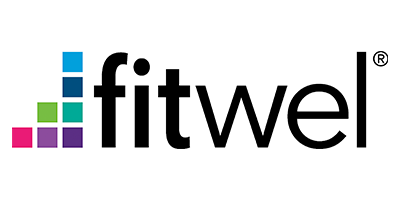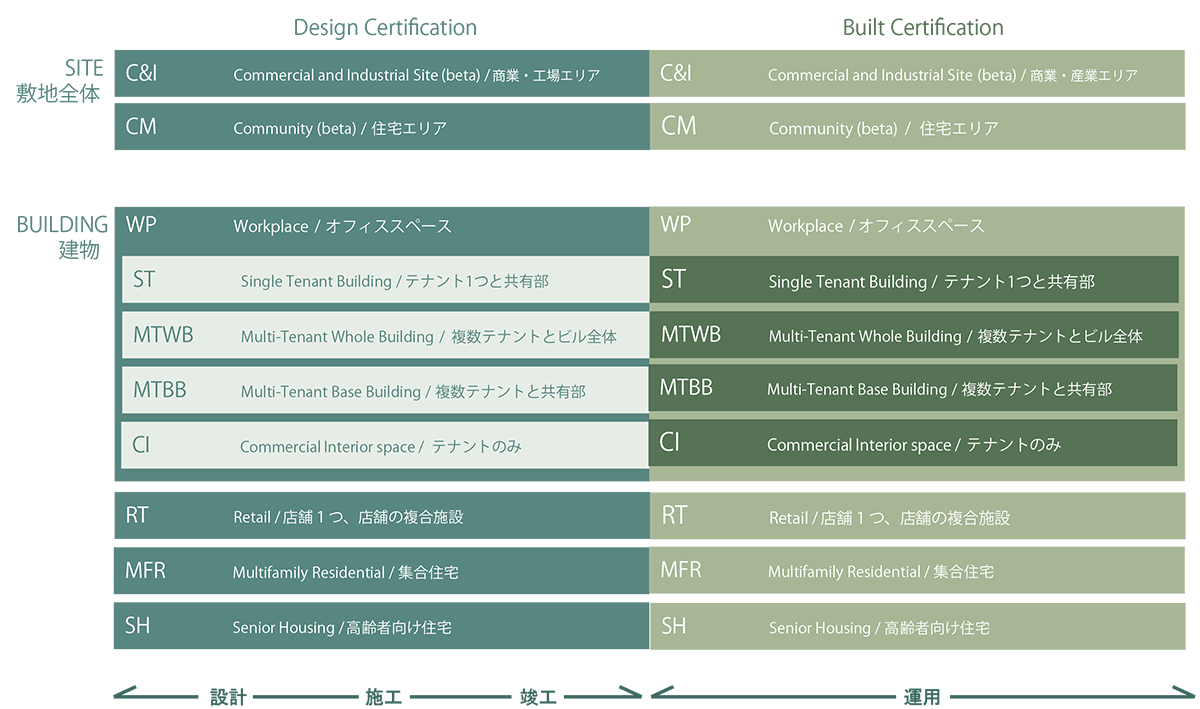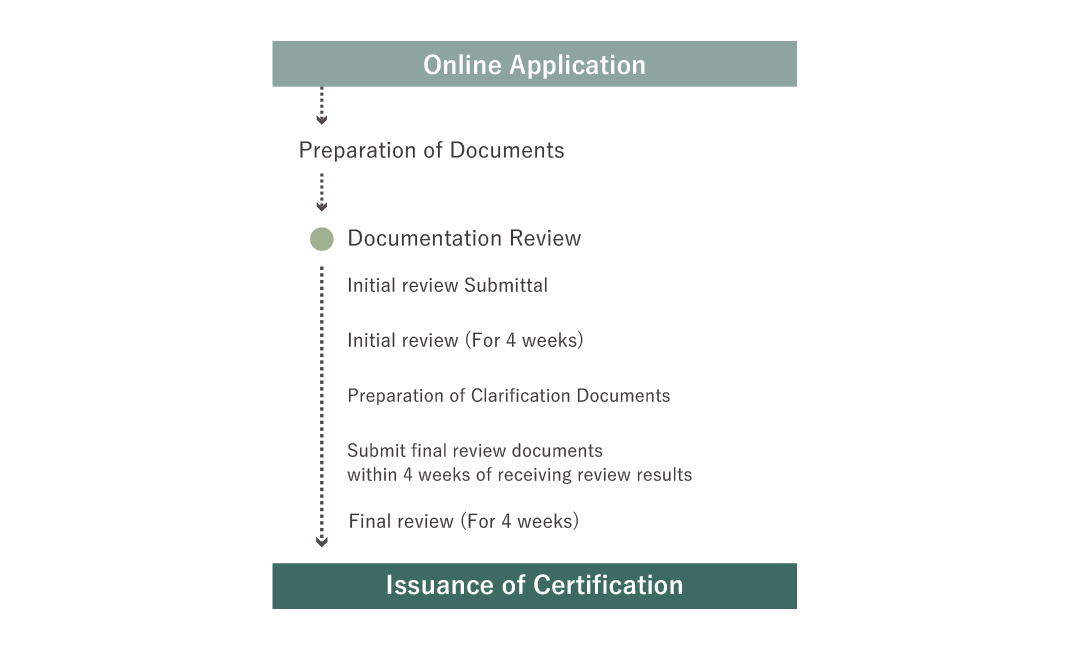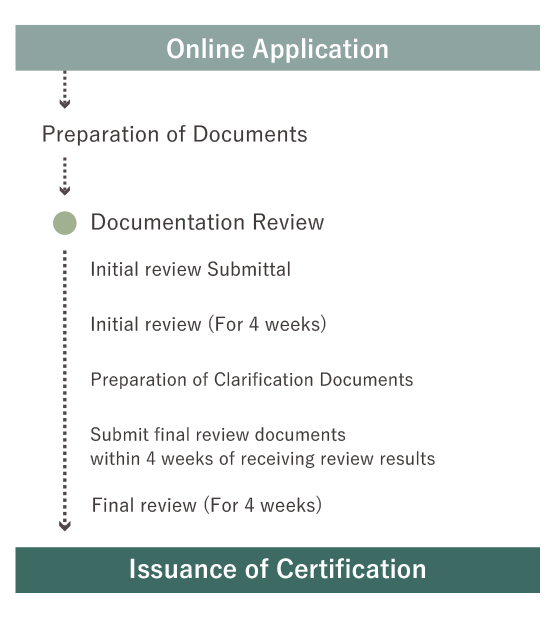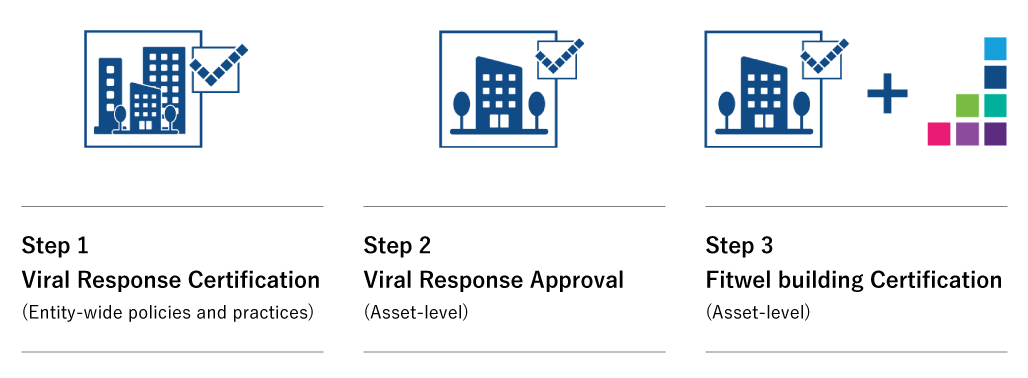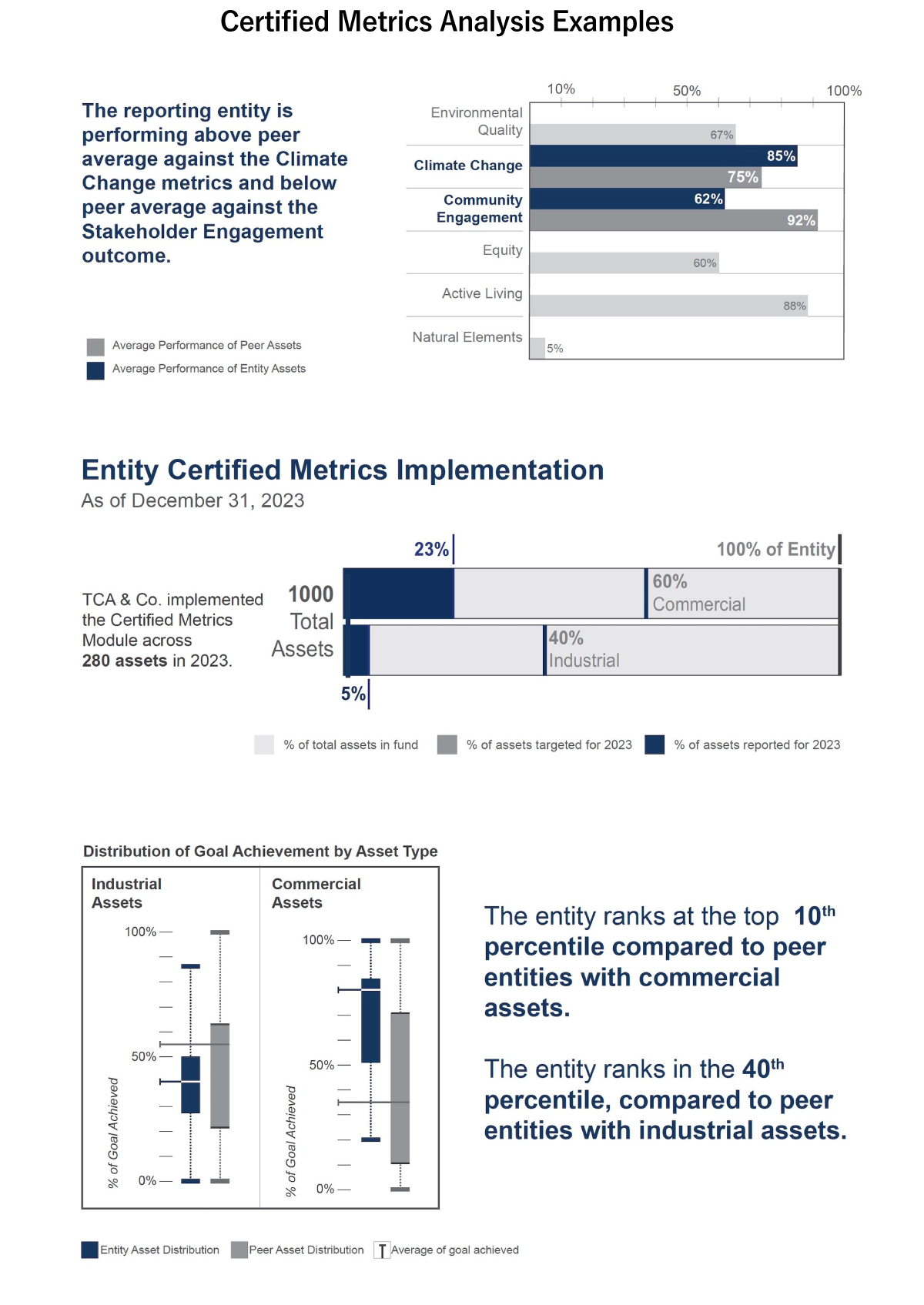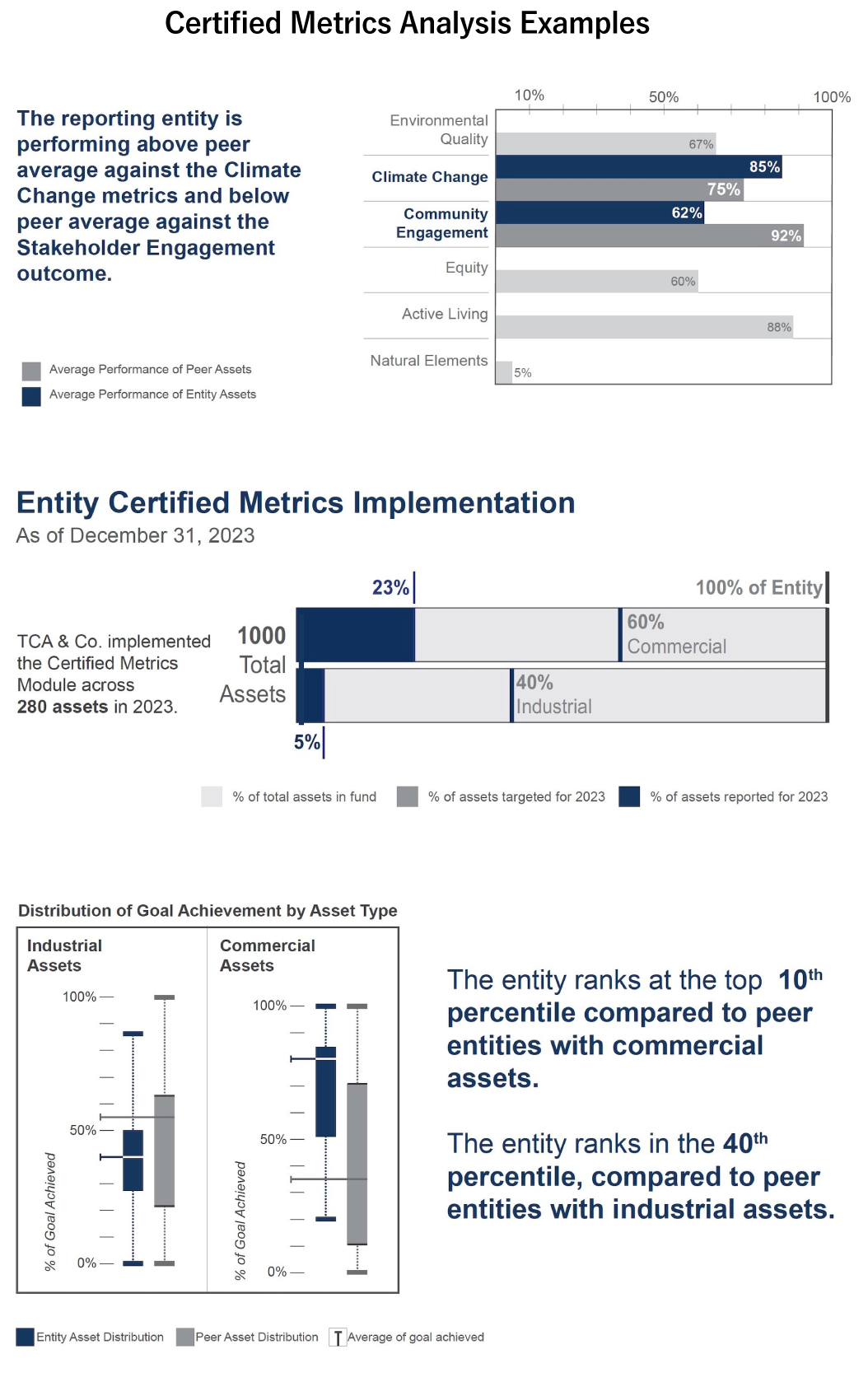Fitwel®
- 1. What is Fitwel®
- 2. Rating Systems
- 3. Categories
- 4. Fitwel®Ambassador
- 5. Process
- 6. Certification levels
- 7. Fees
Fitwel® VRM(Viral Response Module)
ESG Solutions: Certified Metrics
1. What is Fitwel®
Fitwel® is a people-centric real estate certification platform committed to building health for all. Generated by expert analysis of 7,000+ academic research studies, Fitwel® is implementing a vision for a healthier future where all buildings and communities are enhanced to strengthen health and well-being.
Fitwel® was originally created by the U.S. Centers for Disease Control and Prevention (CDC) and U.S. General Services Administration. The CDC remains the research and evaluation partner for Fitwel®. The Center for Active Design is the sole licensed operator of Fitwel®, charged with expanding Fitwel® to the global market.
Fitwel® addresses health holistically as an interconnected system, with no single dominant category or area of focus. Empirical evidence links Fitwel®’s strategies to at least one of seven Health Impact Categories:
- ・ Increases Physical Activity
- ・ Promotes Occupant Safety
- ・ Reduces Morbidity and Absenteeism
- ・ Supports Social Equity
- ・ Instills Feelings of Well-being
- ・ Impacts Surrounding Community Health
- ・ Enhances Access to Healthy Foods
Fitwel® strategies are those with the strongest evidence base and with the highest demonstrated impact on Fitwel®’s Health Impact Categories.
Each strategy is associated with a unique point allocation based on the strength of the science and the demonstrated impact on occupant health. The point value assigned to each strategy was determined by a scientific advisory group of leading public health researchers assembled by the Centers for Disease Control (CDC). The CDC continues to weigh in on strategies and point allocation as the Fitwel® standard and the research behind it evolves.
Fitwel® announced v3 in March 2023 and the beta version has been in effect since December 2023. The current v2.1 will be available for new registrations and use during 2024, but the end date has yet to be determined.
For the latest information, please click here.
There are more than 3,000 Fitwel® registered and certified projects as of January 2023. Information on world wide Fitwel® certification acquisition can be found at
2. Rating Systems
All Fitwel® scorecards are prepared with both standards for properties in the design and construction phase (Design Certification) and for existing (Built Certification), which can be selected on a project-by-project basis.
All strategies are voluntary, with no cost-prohibitive prerequisites, allowing for extensive applicability on diverse projects.
■ SITE
Fitwel®’s site scorecards are for application within communities (residential-oriented developments) and commercial and industrial sites (workplace-oriented developments). These scorecards focus primarily on the exterior composition, connectivity, operations, and maintenance procedures applied within the site.
・Commercial and Industrial Site Scorecard (C&I)
is applicable to contiguous sites that are owned or managed by a single entity, and includes commercial building(s) only. This scorecard impacts all site outdoor areas and common areas that are under the control of site owner/manager.
・Community(CM)
is applicable to privately or publicly owned/managed sites that are contiguous and incorporate at least one residential building. This scorecard impacts all site outdoor areas and common areas.
■ BUILDING
Fitwel®’s building scorecards emphasize internal design and operational strategies, and further evaluate ancillary spaces and building-to-site connectivity to bolster overall health impacts. The building scorecards emphasize occupant amenities, such as commuter infrastructure, daylighting, and stairwell access. These scorecards are available for a range of typologies, including workplaces, multifamily residential, and enclosed retail environments.
・Workplace Scorecards
Four types of scorecards are prepared according to the building characteristics to be evaluated
▫Multi-Tenant Base Building Scorecard:MTBB
is applicable to commercial buildings whose floors and common areas are occupied by multiple tenants. This Scorecard impacts the spaces that are under the control of the building owner/manager, including common areas accessible to tenants, and building owner/manager spaces accessible to onsite staff.
▫Multi-Tenant Whole Building Scorecard : MTWB
is applicable to commercial buildings whose floors and common areas are occupied by multiple tenants. This Scorecard impacts all spaces within the building, including tenant spaces, common areas, and those under the control of building owner/manager.
▫Single-Tenant Building Scorecard : ST
is applicable to commercial buildings whose floors and common areas are occupied by a single tenant. This Scorecard impacts all occupants with all spaces within the building.
▫Commercial Interior Space Scorecard : CI
is applicable to contiguous spaces within a commercial building that are occupied or controlled by a single tenant. The scorecard impacts the spaces occupied by a single tenant.
・Multifamily Residential Scorecard : MFR
is applicable to residential buildings that contain multiple dwelling units. The scorecard impacts all spaces within the building.
・Retail Scorecard : RT
is applicable to retail complexes whose floors and common areas are occupied by multiple tenants, or contiguous spaces within a building that are occupied or controlled by a single tenant. For retail complexes, this scorecard impacts the spaces that are under the control of the building owner/manager, and common areas accessible to visitors. For retail tenants, this scorecard impacts spaces occupied by a single tenant.
・Senior Housing Scorecard : SH
is applicable to properties that provide housing for aging residents.
Applicable properties include those that provide an independent living experience, as well as those that provide assisted living services and/or memory care. Areas where 24-hour skilled nursing care and high level medical care are not covered by the Senior Housing scorecard.
※Campus certification
For adjacent, related, and individual workplace properties, Fitwel® offers the ability for projects to recognize their campuses as Fitwel® certified. Projects seeking this recognition should register and certify each adjacent building separately on the Fitwel® Portal. Once each building is certified, the campus can be awarded an overall score and star rating based on the average score of all buildings within the campus. Pursuing a campus certification is a separate process from achieving a site level certification, as campus represents the average building score using Fitwel®’s workplace scorecards, whereas a site level certification focuses primarily on exterior spaces and the public realm of a project.
3. Categories(Fitwel® v3)
Fitwel® has multiple evaluation strategies to assess the environmental performance of the site and the building from various perspectives. Each evaluation item consists of only optional items, without any mandatory items.
Each system of Fitwel® consists of the following evaluation items. The evaluation items and requirements vary depending on the certification system selected.
■SITE C&I/CM
Evaluation items, details of requirements, and the weight of each requirement differ depending on the authentication system (C&I/CM) selected.
CATEGORY NAME
Description of CATEGORIES
■BUILDING
WP (MTBB, MTWB, ST, CI )/MFR/RT/SH
Evaluation items, details of requirements, and the weight of each requirement differ depending on the authentication system (WP (MTBB, MTWB, ST, CI )/MFR/RT/SH) selected.
CATEGORY NAME
Description of CATEGORIES
*Category names are categorized as follows.
Workspaces… WP (MTBB, MTWB, ST, CI )/RT
Dwelling Unites…MFR/SH
4. Fitwel®Ambassador
A Fitwel® Ambassador is a professional certification recognized by the Center for Active Design. One needs to pass the exam to become a Fitwel® ambassador.
Fitwel® Ambassadors provide the advice necessary to help sites and buildings seeking certification meet the requirements of the individual sections of the Fitwel® scorecards. Woonerf has several qualified professionals.
5. Process
Fitwel® is conducted using a rigorous double-blind review process. All communication regarding the submission of documents and processing is online.
<Application Procedure>
1. Registration with Fitwel® Platform
Basic project information (project name, location, project type, area, number of building users, number of floors, etc.) is entered into the Fitwel® platform once the project registration is completed. Registration of a project provides access to the Platform's interactive scorecard, benchmarking capability, and performance data that summarizes a project's areas of strength and opportunity.
Registration fee: $500 USD per project.
Certification fees are dependent on project size, see pricing.
https://www.fitwel.org/certification#pricing
*Prices are scheduled to increase in April 2024. Please click here for more information.
https://www.fitwel.org/blog/fitwel-pricing-to-increase-in-2024
*Certification must be obtained within 3 years from the date of registration.
2. Preparation of application documents
Select the appropriate Fitwel® scorecard for the property and complete the application documents.
3. Review
There are two reviews for Fitwel® certification: an initial and a final.
Once the documents are complete, an initial review is conducted. Through a
double-blind review process, two independent reviewers assess each project and then confirm a numerical score. After the initial review is completed, the project team receives, via the Fitwel® Portal, details on any additional documentation or clarification needed, offering a direct dialogue between project team and Fitwel® Certification Team. Project teams are permitted one response to the Fitwel® Certification Team within a period of four weeks.
The final Fitwel® Scorecard and a Fitwel® certificate will be issued according to the scores determined in the final review.
In order to maintain the Fitwel® certification, the company must undergo a re-certification review every three years.
6. Certification Levels
Fitwel® certification levels are 90~104 points for 1 star, 105~124 points for 2 stars, and 125~144 points for 3 stars.(All final Fitwel® Scores will be rounded up or down based on two decimal points. )There are no preconditions or any required items.
7. Fees
In addition to the consulting fee, a project registration fee, certification fee, and costs for ordering plaques and seals, if necessary, are required to achieve Fitwel® certification. The certification fee depends on the certification type and the project's total floor area. The renewals, which are every three years, also require certification fees and plaques or seals, if necessary.
For more information on fees, please click here.
1. What is the Fitwel® Viral Response Module(VRM)
The Fitwel® Viral Response Module (VRM) was created in response to The COVID-19 pandemic. This standard is positioned as a third-party certification to mitigate viral transmission in buildings.
For this certification, U.S. Centers for Disease Control and Prevention and a team of global academic leaders collaborated to establish minimum requirements through rigorous, peer-reviewed research.
VRM is institutionally designed to create a multi-faceted approach to enhance indoor environments, encourage behavioral change and build occupant trust.
2. Process
The Fitwel® Viral Response Module (VRM) is expected to be certified in the following three steps.
STEP 1 Viral Response Certification(Entity-wide)
This certification recognizes the effectiveness of Entity-wide* policies and practices.
*Entity-wide is user-defined for each unit that has the same policy. This can be an entire company, a regional portfolio, or a division or region of a company.
There are two review periods: initial and final.
- 1. Once the application is complete, an initial review will be conducted. The initial review will be returned within two weeks with the results and any questions.
- 2. The applicant must prepare a final review document with reinforcing explanations based on the questioned items and respond within two weeks of the return of results.
- 3. Final review will be returned in two weeks.
STEP 2 Viral Response Approval (Asset-level)
Approval can be obtained for the asset that complies with all policies and practices recognized by Viral Response Certification.
The review period is two weeks for each asset.
STEP 3 Fitwel® Building Certification(Asset-level)
Many VRM strategies are compatible with Fitwel® buildingScorecard, making it easier with Viral Response approval to obtain Fitwel® certification.
Fitwel.org. (2024, Feb 5). Fitwel Viral Response Module.
https://www.fitwel.org/viral-response-module
Please note that unlike Fitwel® certification, the Fitwel® Viral Response Module (VRM) is valid for one year.
3. Certification levels
Strategies within the VR module are weighted according to their strength of evidence and level of health impacts, using a 100% scale.
An entity achieving a score of 70-89% will be recognized as Fitwel® Viral Response Certified.
Entities achieving a module score of 90% or above will be recognized as Fitwel® Viral Response Certified with Distinction.
4. Fees
STEP 1 Viral Response Certification(Entity-wide)
| One-time Registration Fee | $500 |
|---|---|
| Annual Certification Fee | $4,500 |
STEP2 Viral Response Approval (Asset-level)
| per asset | $500 |
|---|
Fees are subject to change. For more information on fees, please click here.
ESG Solutions: Certified Metrics
1. What is Certified Metrics Program?
Maximizing Value for Real Estate. Companies often include health and well-being as part of their ESG reporting, yet nearly half of real estate investors say that the social aspect is the most challenging to integrate due to a lack of standardized data (BNP, 2019). They’ve joined forces with their industry partner, EVORA Global, to launch Certified Metrics, an innovative, entity-level solution that builds on Fitwel®’s extensive health evidence. For the first time, the Certified Metrics program will overlay financial value with health outcomes, pointing to clear substantiation of value and risk.
The groundbreaking product will provide data insights, support compliance and ESG reporting submissions in accordance with global standards-setting organizations like GRESB, SASB, the EU Taxonomy, and others, and enable standardized real estate industry performance rankings.
A full product will be launched in 2024.
Fitwel.org. (2024, Feb 5). ESG Solutions: Certified Metrics.
https://www.fitwel.org/esg
2. Six Targeted Outcomes : Quantifying the Impact of “S” on Asset Value
Certified Metrics includes the below six Targeted Outcomes, established through a year-long exploration of the evidence-based relationship between health-promoting built environment interventions, ESG efforts, and financial value. These core themes connect goals around health promotion with economic value creation.
Supporting High-Quality Environments
Assess the effectiveness of your projects and portfolios in addressing fundamental environmental health hazards such as air and water quality, noise, maintenance, and more. By doing so, you enhance sustainability and overall well-being, benefitting.
Engaging with Occupants and Community Stakeholders
Leverage social metrics to gauge collaboration and the resolution of stakeholder concerns. By incorporating feedback and nurturing engagement within projects and portfolios, you build stronger connections and more sustainable relationships.
Optimising Assets for Walking and Active Transportation
Assess the effectiveness of creating an environment that promotes sustainable mobility and well-being through walking, biking, and public transportation. A commitment to sustainable transportation benefits everyone.
Fostering Climate Change Resilience and Preparedness
Assess how well your projects and portfolios mitigate and adapt to the challenges posed by climate change, emergencies, and disasters. By safeguarding real asset resilience, you ensure the long-term stability of your buildings and your valuable investments.
Advancing Equity
Harness social metrics to appraise the successful execution of policies and interventions that guarantee safe access to opportunities, spaces, and health for all occupants and employees. Empower your real assets to promote inclusivity and drive positive change.
Enriching Access to Natural Elements
Employ social metrics to appraise the seamless integration of biophilia into the environment, enhancing the connection between people and nature. Connecting with nature fosters well-being and creates harmonious spaces.
3. What You Can Expect
- A report highlighting certified metrics, including key stats and accompanying narratives to supplement regulatory and compliance reporting, as well as marketing and ESG submissions
- Rankings to provide valuable insights on how your fund’s assets are performing relative to industry competitors
- A gap analysis identifying specific areas for targeted investment and improvement over time
Fitwel.org. “ ESG Solutions: Certified Metrics”.
https://www.fitwel.org/esg. (引用2024-02-05)

 Page Top
Page Top